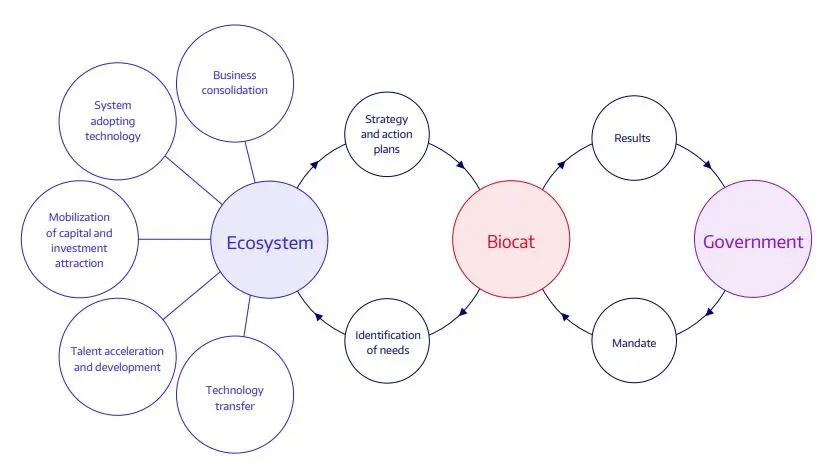Introduction
Innovation clusters are areas where businesses, research institutions, and other organizations collaborate to drive innovation. Innovation clusters create a platform for sharing knowledge, resources, and ideas, promoting innovation and economic growth. They can also often be hubs for local employment opportunities.
The current narrative surrounding innovation clusters mainly centers on top-down governmental initiatives rather than bottom-up grassroots projects involving local communities and broader stakeholders. This approach ignores or obscures the importance of local involvement in establishing successful innovation clusters and often fails to recognize the need for diversity and inclusion in these initiatives.
When it comes to developing prosperous and effective innovation clusters, governments should shift their focus away from top-down strategies towards more collaborative efforts that invite input from all stakeholders. For example, creating advisory boards composed of representatives from government bodies, universities, businesses, and community members can help ensure that all groups are represented in decision-making processes related to developing new projects. Additionally, access to finance should be made available to small business owners who otherwise lack access due to a lack of collateral or formal banking relationships.
Promoting diversity at all levels is essential for innovation ecosystems to represent their respective communities truly. This involves going beyond just talking about diverse representation and taking action through different policies and initiatives. To create meaningful and successful innovation clusters, collaboration is needed between governments, businesses, universities, civil society organizations, and individuals with the shared commitment to ensure its sustainability—economically and socially—with an emphasis on bottom-up approaches rather than top-down ones.
Top-Down Approach
The current narrative on innovation clusters often focuses on top-down government-led initiatives primarily aimed at stimulating economic growth and attracting foreign investment. While these efforts can be beneficial, they can lead to a one-size-fits-all approach that ignores local communities’ unique needs and characteristics. This can limit local ownership and buy-in from the community, making it more difficult for the cluster to reach its full potential.
Furthermore, this narrative usually overlooks the contributions and perspectives of local businesses and organizations, hampering collaboration between stakeholders within a region which is essential for sustainable development.
The following are some reasons why the top-down approach may fail:
- If the local community is not engaged and consulted during the process. This could result in minimal support and ultimately impede its success.
- If the focus is too narrow, resulting in an unsustainable and unbalanced cluster due to a lack of consideration for other industries and possibilities.
- If crucial issues such as access to funding, talent, and infrastructure are not addressed, leading to difficulty for businesses and organizations within the cluster in achieving success.
Bottom-Up Community-Led Approach
To create successful and sustainable innovation clusters, a new narrative must be adopted that recognizes the need for bottom-up initiative and participation from local stakeholders. This means actively involving local actors in the planning process of innovation clusters and designing projects with their needs in mind. This can be done through initiatives such as stakeholder workshops and community-led design.
Furthermore, creating an inclusive environment where diverse perspectives are heard and valued is important. Diversity within innovation clusters should not just be tokenistic but actively promoted at all levels–from talent recruitment for technology roles within cluster companies to representation of ethnicities on boards–to ensure that everyone has an opportunity to benefit from the cluster’s growth. Additionally, access to finance should be made available to small business owners who otherwise lack access due to a lack of collateral or formal banking relationships.
Innovation clusters should prioritize collaboration between stakeholders for mutual benefit, as well as actively creating meaningful opportunities for those who have been traditionally underserved or excluded. Only by doing this can innovation clusters become hubs of equitable economic growth, spurring creativity and driving improvements in well-being across the region they serve.
Successful innovation clusters with a bottom-up approach
The BioRegion of Catalonia is an excellent example of an innovation cluster that has succeeded through a bottom-up approach. The region was developed following a participatory planning process, which saw local businesses, research institutions, and other stakeholders consulted on the project from the beginning. This holistic approach enabled various groups to contribute their perspectives, needs, and resources to the region’s development.

Source: BioRegion of Catalonia
The BioRegion of Catalonia, with more than 1,500 companies and 91 research entities, has established itself as one of Europe’s leading biotech clusters. Due to its commitment to diversity and inclusion, which includes recruiting talented technology professionals and representation on boards and facilitating access to finance for small business owners irrespective of their collateral or banking status. This has enabled the region to grow and develop significantly, attracting substantial international investor interest in recent years.
The EPFL Innovation Park is another great example of an innovation cluster that has achieved success through a bottom-up approach. This approach sees local businesses and organizations actively collaborating with each other to create a thriving hub of innovation, with over 500 companies and 2,600 researchers. What makes this project especially successful is its emphasis on inclusivity–not only are stakeholders from different backgrounds consulted but access to finance is also made available to small business owners without the need for collateral or formal banking relationships.
The BioRegion and EPFL Innovation Park have seen success through their participatory planning processes, creating a prosperous ecosystem that includes everyone within the cluster. These processes include creating meaningful opportunities for traditionally underserved or excluded groups and promoting collaboration between stakeholders to maximize mutual benefit from the cluster’s development. The EPFL Innovation Park model is a global example of how collective action and shared objectives can result in economic growth while respecting and supporting diversity.
Conclusion
The current narrative surrounding innovation clusters often overlooks the importance of bottom-up, community-led initiatives and the perspectives of local actors and stakeholders. The successes of the BioRegion and EPFL Innovation Park demonstrate that these approaches can lead to growth, prosperity, and inclusivity – something policymakers should consider when creating new narratives going forward. By recognizing the unique assets of a region’s local actors and incentivizing meaningful collaborations between stakeholders, equitable economic benefits can be achieved that help create more innovative and inclusive societies globally.




